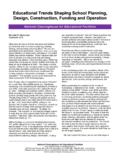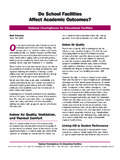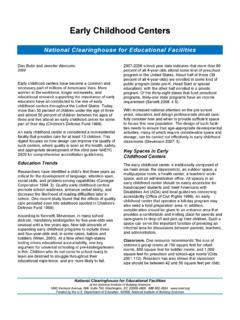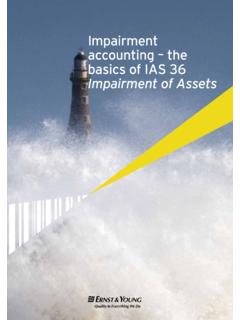Transcription of Fundraising Basics for Private School Facilities …
1 FFuunnddrraaiissiinngg BBaassiiccss ffoorr PPrriivvaattee SScchhooooll FFaacciilliittiieess National Clearinghouse for Educational Facilities National Clearinghouse for Educational Facilities at the National Institute of Building Sciences 1090 Vermont Avenue, NW, Suite 700, Washington, DC 20005-4905 888-552-0624 Funded by the Department of Education 2009, National Institute of Building Sciences Arthur H. Roach Fundraising Consultant 2009 There is one problem many Private schools are happy to face: coping with growth. When the size of the student body is increasing and the waiting list for enrollment grows longer, a School may assume that it is accomplishing its mission and educational goals. For Private schools, a full complement of tuition and fees permits operating and program costs to be covered. Schools usually accommodate growth with new buildings or with renovated Facilities adapted to support instructional needs.
2 This may require a construction loan from a bank, an encumbrance not usually funded by an institution s annual operating budget. A construction loan may be reduced or may be unnecessary if fund raising generates enough capital to cover the costs of the project before building begins. Or, a major portion of the loan may be repaid later through funds given to the School as charitable contributions. Individuals, corporations and foundations in the United States contributed more than $295 billion to nonprofits in 2006. This figure includes contributions to all non-profit corporations holding IRS 501(c)(3) status, such as arts organizations, healthcare and social service agencies, churches and church-related institutions, as well as schools and libraries. Foundation grants account for $ billion, or only about 12 percent of this 2006 total.
3 Corporate contributions were even less at $ billion, or approximately four percent. Gifts from individuals (including bequests), at $246 billion, accounted for 84 percent of all charitable giving. The term contributed income is important. It is a gift. The donor does not buy a magazine subscription, a program ad or a candy bar. According to the official language of the IRS, the donor has received neither goods nor services in consideration for the gift. The donor does, however, receive a thank you, an acknowledgment, and the option to reduce taxable income by itemizing deductions on IRS Form 1040 Schedule A. Most K-12 institutions seeking tax-deductible contributions are Private or church-related schools that have obtained nonprofit incorporation within their state and have been designated a 501(c)(3) organization by the IRS.
4 As such, they have articles of incorporation, bylaws, and independent, deliberative not advisory boards of directors with fiduciary responsibility. Some schools are wholly owned and operated by a church. If the church is part of a denomination that predates the IRS, it might not need 501(c)(3) status in order to receive tax-deductible contributions. Contributions to an unincorporated church School are actually designated gifts to the sponsoring church. These schools will encounter foundations and corporations whose guidelines do not permit contributions to churches. Tax-deductible gifts may be made to public schools. Fund raising in public schools is usually associated with projects that, for example, provide new band uniforms or bleachers. As individual donors, Americans expect their taxes to cover costs related to public School buildings, so they are unaccustomed to being asked for charitable financial support to build or renovate schools.
5 Public schools considering a campaign to fund capital projects with contributed income should identify a Fundraising consultant who has specific experience in this highly specialized area. Raising money for new or renovated Facilities is called a capital campaign. In addition to funding the project that motivated it, a successful capital campaign builds and refines a School s development program for the foreseeable future; builds visible volunteer leadership that should continue to support the institution as well as build the School s credibility in the philanthropic sector; and stretches, redefines, and expands the level of contributed income a School should expect to receive after the campaign is completed. 2 Fundraising Basics for Private School Facilities National Clearinghouse for Educational Facilities at the National Institute of Building Sciences 1090 Vermont Avenue, NW, Suite 700, Washington, DC 20005-4905 888-552-0624 Funded by the Department of Education 2009, National Institute of Building Sciences Setting up a Comprehensive Development Program Obtain Fundraising software ( , Blackbaud s The Raiser s Edge, or DonorPerfect, ) or subscribe to one of the web-based programs ( , ).
6 These are more than glorified address books. They anticipate the way you will want to record and report donor and potential donor information. You will accurately record gifts and pledges, as well as generate acknowledgements and payments. A good software program greatly enhances the efficiency of the persons assigned with Fundraising responsibilities, provided they receive good training in its use. Such a program has the effect of adding staff without the expense. Invest in the staff time to record data and build donor profiles. In addition to names and addresses, information like preferred salutations, relationship to the School ( , board member, parent, past parent, alumni and class year, vendor, area business, friend), and contribution history will help you build a strategy for identifying and contacting donors to a capital campaign.
7 Knowing their college, graduate School , profession, and interests will assist in making connections with other constituents. Having complete, accurate, and accessible data is critical for developing solicitation strategies. There is no such thing as too much information. Implement all components of a comprehensive development program. Annual fund. Begin asking people for money now, regularly, twice a year. Simply ask for unrestricted gifts to your School ; but not for your capital campaign not yet. An annual fund builds the donor database and acquaints people with the idea of giving to and being thanked for their contributions to your School . Regularly asking for money keeps you focused on the reasons you are seeking financial support through contributions. You become accustomed to describing your needs; that is, composing a case for support.
8 You may choose to target alumni, parents, and friends differently. Whatever your plan, an annual fund builds donor relations and donor giving histories an important first step in preparing for the major gifts needed in a capital campaign. Major gifts. The Board of Directors should always have a standing committee devoted to identifying, cultivating, and ultimately soliciting contributions from persons capable of making major gifts. The board must define the term major gift within the School s context and needs. It might be $10,000 (or less) or $100,000 (or more). If a capital campaign is anticipated within two or three years, delay asking for an assured major gift until it can be incorporated into the campaign either as an advance or leadership gift. Part of cultivating donors might include keeping them abreast of campaign plans and the important role they will play as leadership donors.
9 When the campaign is completed, your School will have experience in developing relationships with major donors. There will always be a need for major gifts. Deferred or planned giving. Another standing committee of the Board of Directors should be assigned the task of encouraging deferred or planned gifts, such as bequests and annuities. Creating a society that recognizes planned giving donors can be an effective tool to promote these gifts. An official from the bank where your School has its accounts may be willing to sit on your board and assign a staff member to preside over that committee. While the bank officer can oversee the technical considerations, someone else may assume responsibility for a proactive stance towards deferred gifts. An active and visible development program for deferred gifts adds to the credibility and long-range context for a capital campaign.
10 Special event. Identify and establish a special annual Fundraising event. In addition to the amount of money that is to be raised, be clear about other goals, such as good publicity and public relations. Be aware that a large percentage of the ticket price for special events may not be tax deductible, and much of the other money collected at a special event is earned income from sales (not tax deductible) rather than "contributed income." The IRS expects vigilant oversight of this. If someone buys a ticket and receives a meal, the value of the meal must be indicated. If your special event is a silent or live auction and an attendee successfully bids on a pair of opera tickets, you may not indicate a charitable contribution up to the value of the tickets. The value of the special event to your future capital campaign includes identifying volunteer leaders and workers, adding names of School friends to the database, and recording amounts of Fundraising Basics for Private School Facilities 3 National Clearinghouse for Educational Facilities at the National Institute of Building Sciences 1090 Vermont Avenue, NW, Suite 700, Washington, DC 20005-4905 888-552-0624 Funded by the Department of Education 2009, National Institute of Building Sciences money transacted by attendees at the special event.















